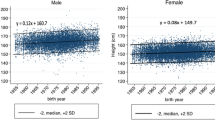Abstract
Shared genetic inheritance results in a high correlation in the heights of brothers, but experiences in childhood and adolescence can intervene. Poor diet, disease, and heavy labor can prevent the achievement of height potentials. If families cannot control variations in these conditions, the heights of brothers will be less strongly correlated. We use heights measured at military conscription examinations from three communities in nineteenth-century Belgium. The Generalized Estimating Equation procedure allows us to estimate effects of covariates on mean heights as well as the correlations within families. Both average height and the correlation of brothers’ heights differed by socioeconomic status. Members of the local elite were taller and the heights of brothers in those families were more strongly correlated. This suggests that elite families were much better able to control the environmental challenges faced by their offspring.
Similar content being viewed by others
References
Alter, G. (1988). Family and the female life course: The women of Verviers, Belgium, 1849–1880. Madison, WI: University of Wisconsin Press.
Alter, G. (2004). Height, frailty, and the standard of living: Modeling the effects of diet and disease on declining mortality and increasing height. Population Studies: A Journal of Demography, 58, 265–279.
Alter, G., Neven, M., & Oris, M. (2004a). Stature in transition: A micro-level study from nineteenth-century Belgium. Social Science History, 28, 231–247.
Alter, G., Neven, M., & Oris, M. (2004b). Mortality and modernization in Sart and surroundings, 1812–1900. In T. Bengtsson, C. Campbell, & J. Z. Lee (Eds.) Life under pressure: Mortality and living standards in Europe and Asia, 1700–1900 (pp. 173–208). Cambridge, MA: MIT Press.
Beaty, T. H., Skjaerven, R., Breazeale, D. R., & Liang, K. Y. (1997). Analyzing sibship correlations in birth weight using large sibships from Norway. Genetic Epidemiology, 14, 423–433.
Bengtsson, T., Campbell, C., & Lee, J. Z. (2004). Life under pressure: Mortality and living standards in Europe and Asia, 1700–1900. Cambridge, MA: MIT Press.
Bogin, B. (1999). Patterns of human growth. New York: Cambridge University Press.
Capron, C. (1996). La population de Limbourg au milieu du 19e siècle: un essai de démographie différentielle. M.A. thesis, History, University of Liège.
Capron, C. (1998). Mortalité différentielle et causes de décès à Limbourg au milieu du 19e siècle. Bulletin du Crédit Communal, 52, 45–62.
Fogel, R. W., & Costa, D. L. (1997). The theory of technophysio evolution, with some implications for forecasting population, health care costs, and pension costs. Demography, 34, 49–66.
Haines, M. R. (2004). Growing incomes, shrinking people: Can economic development be hazardous to your health? Historical evidence for the United States, England, and the Netherlands in the nineteenth century. Social Science History, 28, 249–270.
Komlos, J. (1995). The biological standard of living in Europe and America, 1700–1900: Studies in anthropometric history. Aldershot, UK: Variorum.
Komlos, J. (1998). Shrinking in a growing economy? The mystery of physical stature during the industrial revolution. Journal of Economic History, 58(3), 779–802.
Lauderdale, D. S., & Rathouz, P. J. (1999). Evidence of environmental suppression of familial resemblance: Height among US Civil War brothers. Annals of Human Biology, 26, 413–426.
Liang, K. Y., & Beaty, T. H. (2000). Statistical designs for familial aggregation. Statistical Methods in Medical Research, 9, 543–562.
Liang, K. Y., & Zeger, S. L. (1986). Longitudinal data analysis using generalized linear-models. Biometrika, 73, 13–22.
Liang, K. Y., & Zeger, S. L. (1993). Regression analysis for correlated data. Annual Review of Public Health, 14, 43–68.
Livi Bacci, M. (1991). Population and nutrition: An essay on European demographic history. Cambridge [England]; New York: Cambridge University Press.
Mueller, W. H. (1976). Parent-child correlations for stature and weight among school-aged children: A review of 24 studies. Human Biology: An International Record of Research, 48, 379–397.
Pelletier, D. L. (1994). The relationship between child anthropometry and mortality in developing countries: Implications for policy, programs and future research. Journal of Nutrition, 124, s2047–s2081.
Pelletier, D. L., Frongillo, E. A., & Habicht, J. P. (1993). Epidemiologic evidence for a potentiating effect of malnutrition on child mortality. American Journal of Public Health, 83, 1130–1133.
Silventoinen, K. (2003). Determinants of variation in adult body height. Journal of Biosocial Science, 35, 263–285.
Silventoinen, K., Lahelma, E., Lundberg, O., & Rahkonen, O. (2001). Body height, birth cohort and social background in Finland and Sweden. European Journal of Public Health, 11, 124–129.
Szreter, S., & Mooney, G. (1998). Urbanization, mortality, and the standard of living debate: New estimates of the expectation of life at birth in nineteenth-century British cities. Economic History Review, 51(1), 84–112.
Vliebergh, E., & Ulens, R. (1912). L’Ardenne. La population agricole au XIXe siècle. Brussels: Librairie Albert Dewit.
Acknowledgments
We are grateful to Diane Lauderdale and Paul Rathouz for their help and advice, and John Hanfelt for making the GEE4 program available. We thank Alan Bittles, Michael Murphy, and David Reher for comments on an earlier draft. George Alter is grateful to the Institut National des Etudes Démographique for facilities and support. This research was funded by NIH grant P01 AG18314-01A1.
Author information
Authors and Affiliations
Corresponding author
Rights and permissions
About this article
Cite this article
Alter, G., Oris, M. Effects of Inheritance and Environment on the Heights of Brothers in Nineteenth-Century Belgium. Hum Nat 19, 44–55 (2008). https://doi.org/10.1007/s12110-008-9029-1
Published:
Issue Date:
DOI: https://doi.org/10.1007/s12110-008-9029-1




